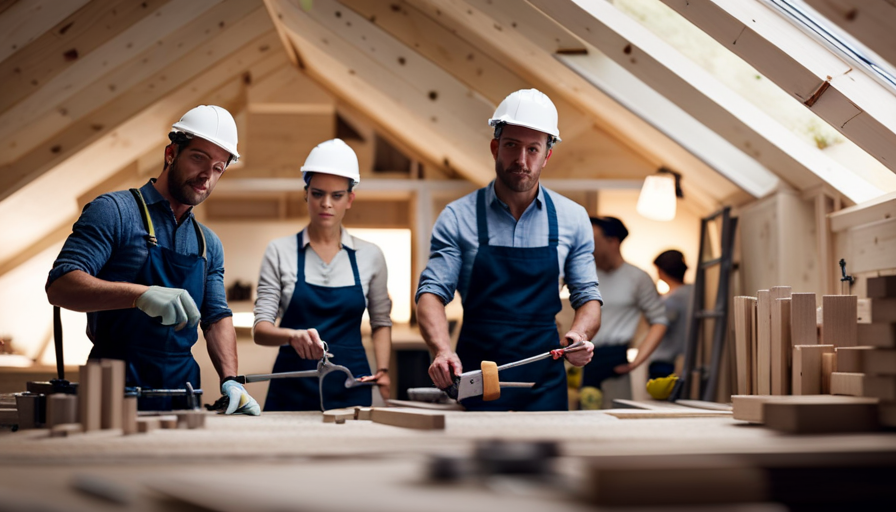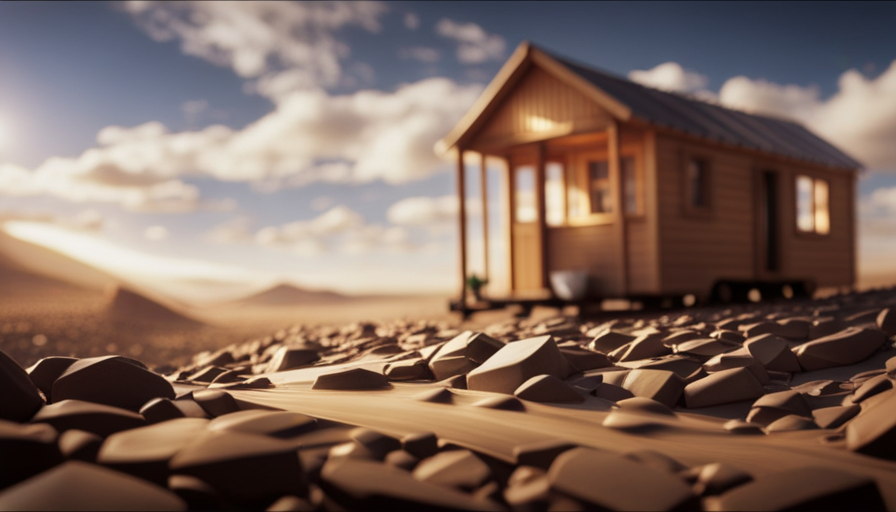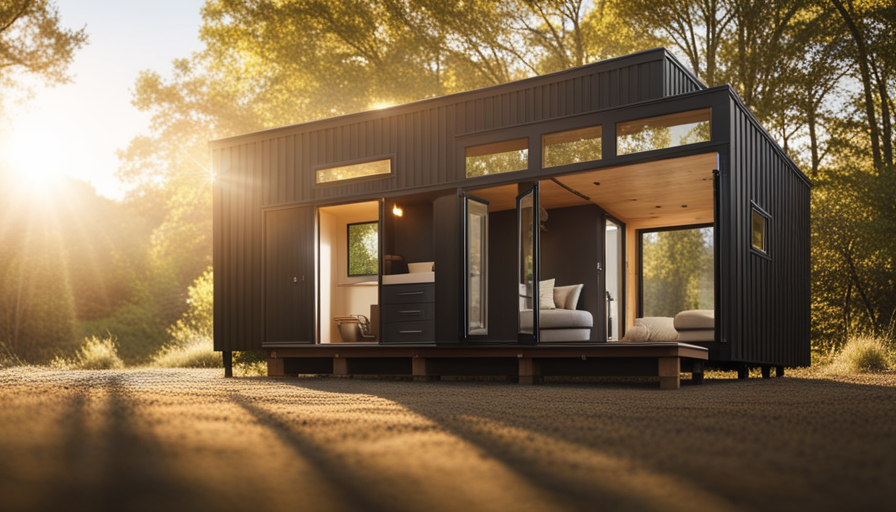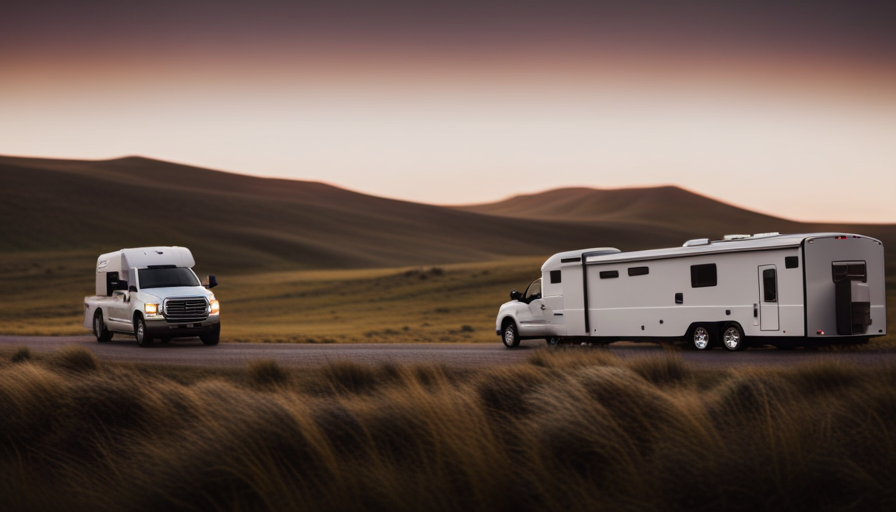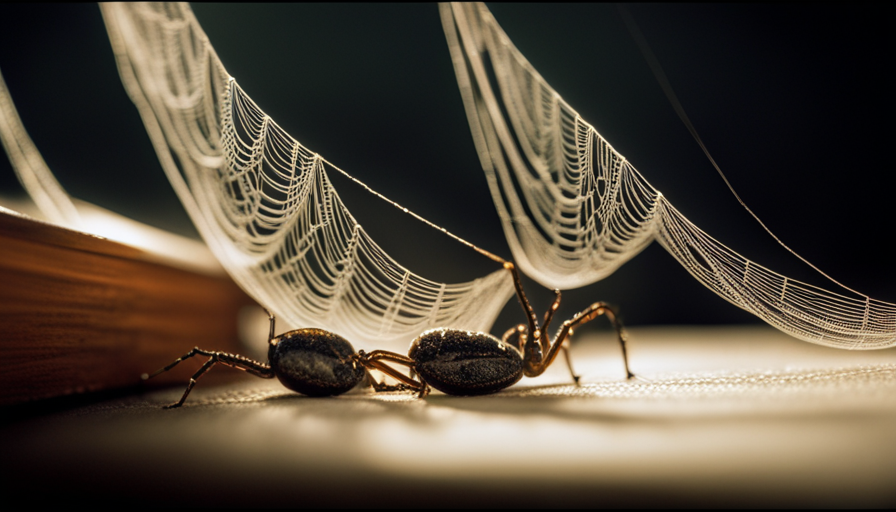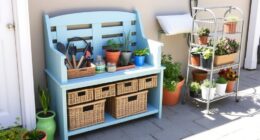Building a tiny house is like embarking on a thrilling voyage into the world of minimalism. This journey requires careful planning, creativity, and determination.
Just like a captain navigating through uncharted waters, building a tiny house involves understanding the concept, acquiring necessary skills, and navigating through the maze of permits and regulations.
In this article, I will guide you through the process of building a tiny house, providing you with valuable insights and practical tips along the way. From researching and planning to interior design and long-term sustainability, we will explore every step of the journey.
While the idea of constructing your own tiny house may seem daunting, fear not! With the right knowledge and resources, you can turn your dream into a reality. So, fasten your seatbelts and get ready to embark on this exciting endeavor.
Let’s dive in and discover just how hard it is to build a tiny house.
Key Takeaways
- Building a tiny house requires careful planning, creativity, and determination.
- Tiny houses maximize space and minimize waste, making them popular for simplicity and sustainability.
- Research and planning are necessary before starting construction, including designs, layouts, local zoning, building codes, materials, and construction techniques.
- Choosing the right location and obtaining permits and complying with regulations are crucial for legal and safe occupancy.
Understanding the Concept of Tiny Houses
You’ll quickly grasp the concept of tiny houses, their charm and efficiency. Tiny houses are small, fully functioning homes that are typically between 100 and 400 square feet. They are designed to maximize space and minimize waste, making them a popular choice for those who value simplicity and sustainability.
Conceptualizing a tiny house involves carefully considering the layout, materials, and features that will be included. It’s important to think about what you truly need in a home and how you can make the most of limited space.
One of the main advantages of building a tiny house is the cost savings. Tiny houses are significantly cheaper to build and maintain compared to traditional homes. The cost estimation for a tiny house can vary depending on factors such as size, location, and materials used. However, it is generally much more affordable than a conventional house. This makes it a great option for those looking to downsize or live mortgage-free.
Transitioning into the next section about research and planning, it’s important to thoroughly research and plan before diving into the construction process. By carefully considering your needs, budget, and available resources, you can ensure that your tiny house project is successful.
Research and Planning
Researching and carefully strategizing before embarking on this endeavor will undoubtedly contribute to the successful construction of a compact dwelling. It’s essential to conduct thorough research to understand the various aspects involved in building a tiny house. Start by exploring different designs and layouts to find one that suits your needs and preferences.
Look into local zoning and building codes to ensure compliance with regulations. Additionally, research different materials and construction techniques that are best suited for tiny houses.
Budgeting is another crucial aspect to consider during the research and planning stage. Determine how much you’re willing to spend on your tiny house project and create a detailed budget. Research the costs of materials, tools, and any professional help you may require. Consider all the necessary expenses, such as permits and inspections.
Once you’ve completed the research and budgeting phase, it’s time to move on to acquiring the necessary skills. By gaining knowledge and understanding of the construction process, you’ll be better equipped to tackle the challenges that may arise during the building process.
Transitioning into the next section, acquiring the necessary skills is an important step in ensuring the successful construction of your tiny house.
Acquiring the Necessary Skills
To successfully construct a compact dwelling, it’s important to develop the skills needed for the project. One interesting statistic to consider is that 70% of tiny house owners have reported learning new construction skills during the building process. Learning carpentry and construction techniques is crucial when it comes to building a tiny house. These skills include understanding how to properly frame walls, install windows and doors, and construct a sturdy roof. Additionally, knowledge of electrical and plumbing systems is essential to ensure that the tiny house is functional and safe.
One way to acquire these skills is through research and practice. There are numerous online resources, books, and workshops available that provide step-by-step instructions and guidance on construction techniques specific to tiny houses. Many tiny house enthusiasts also join local building communities or volunteer on construction projects to gain hands-on experience and learn from experienced builders. By actively engaging in learning carpentry and construction techniques, individuals can feel more confident in their ability to successfully construct a tiny house.
With the necessary skills in hand, the next step is to choose the right location for the tiny house. This decision is crucial as it will determine the overall experience and feasibility of living in a tiny house.
Choosing the Right Location
Finding the perfect spot for your compact dwelling can be an exciting adventure, as it opens up a world of possibilities for your future tiny home. When it comes to finding suitable land, there are a few factors to consider.
Firstly, look for a location that aligns with your lifestyle and preferences. Do you want to be close to nature, or do you prefer the convenience of urban living? Consider the proximity to amenities such as grocery stores, hospitals, and schools.
Secondly, take into account zoning restrictions in the area you’re interested in. Some areas have specific regulations regarding the size and type of dwellings allowed. Research the local zoning laws to ensure that your tiny house will be permitted.
Lastly, consider the accessibility and infrastructure of the location. Are there roads, utilities, and services available? Is the land suitable for construction? These factors will impact the cost and feasibility of building your tiny house.
Finding the right location is just the first step in the process of building a tiny house. Once you’ve secured the land, the next challenge is obtaining permits and navigating the regulations that govern tiny house construction.
Obtaining Permits and Regulations
Once you’ve secured the perfect location for your compact dwelling, you’ll need to navigate the challenging process of obtaining permits and complying with regulations. This step is crucial to ensure that your tiny house is legal and safe to occupy.
The first thing you’ll need to do is complete a permit application. This will require you to provide detailed information about your intended structure, including its size, materials, and utilities. It’s important to thoroughly research and understand the building codes in your area before submitting your application, as failure to comply can result in delays or even rejection.
Building codes vary by location, so it’s crucial to familiarize yourself with the specific regulations that apply to your tiny house. These codes typically cover aspects such as minimum square footage, ceiling height, electrical and plumbing systems, and safety requirements. Some areas may also have zoning restrictions that dictate where tiny houses can be placed.
Navigating the permit and regulation process can be complex and time-consuming, but it’s a necessary part of building a tiny house. Once you’ve successfully obtained the necessary permits and ensured compliance with regulations, you can move on to designing and building the structure.
Designing and Building the Structure
Crafting a unique and personalized abode, from start to finish, involves conceptualizing and constructing a structure that perfectly embodies your vision and lifestyle. When it comes to designing and building the structure of a tiny house, there are various building techniques and material selections to consider. These choices will not only influence the overall look and feel of your tiny house but also impact its durability and functionality.
Building techniques for tiny houses often include traditional stick framing, panelized construction, or even using shipping containers. Each method has its own advantages and considerations, such as cost, ease of construction, and energy efficiency. Material selection is also an essential aspect of building a tiny house. From the foundation to the roof, every component must be carefully chosen to ensure strength, insulation, and longevity.
When designing the structure of your tiny house, it’s crucial to strike a balance between aesthetics and practicality. Consider the layout and flow of the space, as well as the size and placement of windows to maximize natural light and ventilation. Additionally, think about the weight distribution and how it will affect the overall stability of your tiny house.
As you finalize the design and start construction, it’s important to keep in mind the subsequent section about electrical and plumbing considerations. Proper planning and integration of these systems are crucial for a comfortable and functional tiny house.
Electrical and Plumbing Considerations
Moving on from the process of designing and building the structure of a tiny house, we now come to the important considerations of electrical and plumbing installations.
When it comes to electrical safety in a tiny house, it’s crucial to ensure that all electrical work is done by a qualified professional. This includes the installation of wiring, outlets, and light fixtures. Additionally, it’s important to have a proper electrical panel with circuit breakers to prevent overloading and electrical hazards.
As for plumbing installation, it’s necessary to plan and install all plumbing fixtures carefully. This includes the installation of water supply lines, drainage pipes, and fixtures such as sinks, toilets, and showers. It’s important to ensure that all plumbing work is done in compliance with local building codes to avoid any potential issues in the future.
Taking the time to properly design and install the electrical and plumbing systems in your tiny house will ensure both functionality and safety. With these considerations in mind, we can now move on to the next section about utilizing space efficiently, where we’ll explore ways to maximize every square inch of your tiny house without sacrificing comfort or convenience.
Utilizing Space Efficiently
To truly optimize your living experience, it’s essential to maximize every square inch of your compact home by utilizing space efficiently. Here are some tips to help you make the most of your tiny house:
-
Invest in multi-functional furniture: Look for items that can serve multiple purposes, such as a sofa that can also be used as a bed, or a dining table that can double as a workspace. This will help you save space and make your home more versatile.
-
Utilize vertical space: Make use of walls by installing shelves, hooks, and hanging organizers. This will free up valuable floor space and provide additional storage options for items like books, kitchen utensils, and clothing.
-
Get creative with storage solutions: Think outside the box when it comes to storage. Consider using under-bed storage, utilizing the space under stairs, or installing built-in storage units that make use of otherwise unused areas.
-
Use modular and stackable furniture: Opt for furniture that can be easily rearranged or stacked when not in use. This will allow you to adapt your space to different needs and save space when necessary.
-
Incorporate hidden storage: Look for furniture pieces that have hidden compartments or secret storage spaces. This will help you maximize storage without sacrificing aesthetics.
By maximizing storage and incorporating multi-functional furniture, you can create a compact home that’s both functional and efficient.
In the next section, we’ll explore interior design and decoration, which will further enhance the ambiance of your tiny house.
Interior Design and Decoration
When it comes to creating a cozy and inviting living space, you’ll want to focus on the interior design and decoration of your compact home.
In a tiny house, every inch matters, so it’s important to choose furnishings that are not only functional but also maximize space. Opt for multipurpose furniture, such as a sofa bed or a coffee table with storage compartments, to make the most of limited square footage. Additionally, consider using wall-mounted shelves and cabinets to keep the floor clear and create a sense of openness.
When it comes to color schemes, light and neutral tones work best in tiny houses as they make the space appear larger and brighter. Whites, creams, and pastels can help create a serene and airy atmosphere. However, don’t be afraid to add pops of color through accent pieces, such as throw pillows or artwork, to inject personality into your tiny home.
Transitioning into the next section about maintenance and long-term sustainability, it’s essential to consider how the interior design and decoration choices you make affect the overall functionality and durability of your tiny house.
Maintenance and Long-Term Sustainability
To ensure the longevity and eco-friendliness of your compact home, it’s crucial that you prioritize maintenance and sustainability, fostering a sense of pride and responsibility in the care of your space.
Maintaining a tiny house may seem easier due to its small size, but it comes with its own set of challenges. One of the main maintenance challenges is keeping the space clean and organized. With limited storage options, it’s important to regularly declutter and find creative ways to maximize storage efficiency.
Another maintenance challenge is maintaining the exterior of the house. Tiny houses are often built with materials that require regular upkeep, such as wood siding or metal roofing. Regular inspections and maintenance, such as repainting or sealing, are necessary to protect the exterior from weather damage and ensure its longevity.
In terms of sustainability, tiny houses have a smaller environmental footprint compared to traditional homes. They typically require less energy to heat and cool and use fewer resources during construction. However, it’s important to be mindful of the materials used in the construction and the impact they may have on the environment. Choosing sustainable and eco-friendly materials, such as reclaimed wood or low VOC paints, can further reduce the environmental impact of your tiny house.
While maintaining a tiny house may have its challenges, prioritizing maintenance and sustainability is essential for the longevity of your home and reducing its environmental impact. By staying organized, regularly maintaining the exterior, and choosing eco-friendly materials, you can ensure that your tiny house remains a comfortable and sustainable living space for years to come.
Frequently Asked Questions
How much does it cost to build a tiny house?
When it comes to the cost of building a tiny house, it can vary greatly depending on various factors. A cost estimation and breakdown are essential to understand the financial commitment involved.
Factors such as location, materials used, and the level of customization desired can all impact the final cost. It’s important to research and plan carefully to ensure you stay within your budget while still achieving your dream tiny home.
What are some common mistakes to avoid when building a tiny house?
When building a tiny house, it’s important to be aware of common mistakes that can occur during the building process. These mistakes can include poor planning, inadequate insulation, improper wiring, and lack of storage space.
To avoid these errors, it is crucial to thoroughly research and plan every aspect of the construction. Additionally, seeking guidance from experienced builders or professionals can provide valuable insights and help ensure a successful and functional tiny house.
Can I build a tiny house on wheels?
Yes, you can build a tiny house on wheels. Building a tiny house on wheels offers flexibility and mobility. However, it’s important to be aware of building regulations and parking regulations in your area.
These regulations may vary depending on your location, so it’s crucial to do thorough research and ensure compliance. Additionally, consulting with professionals or experienced builders can help you navigate any legal requirements and ensure a smooth process.
Are there any restrictions on living in a tiny house?
Living in a tiny house is subject to legal requirements and zoning regulations. These restrictions vary depending on the location and jurisdiction. It’s crucial to research and comply with local laws before moving into a tiny house.
Legal requirements may include obtaining building permits and meeting specific safety standards. Zoning regulations often dictate where tiny houses can be placed, such as designated areas or on private property.
It’s essential to consult local authorities to ensure compliance and avoid any legal issues.
What are the advantages of living in a tiny house compared to a traditional home?
Living in a tiny house offers numerous advantages over a traditional home. Firstly, it promotes a minimalist lifestyle, allowing for a more simplified and clutter-free existence.
Additionally, tiny houses are more affordable, requiring less money to build and maintain. They’re also more environmentally friendly, consuming less energy and producing fewer carbon emissions.
Furthermore, tiny houses provide the freedom to live a more flexible and mobile lifestyle, with the ability to easily move and explore new locations.
Ultimately, choosing a tiny house offers a unique and fulfilling way of living.
Conclusion
Building a tiny house may seem daunting, but with proper research, planning, and acquiring the necessary skills, it’s definitely achievable.
Choosing the right location, obtaining permits, and considering electrical and plumbing requirements are important steps to ensure a successful build.
Utilizing space efficiently and designing the interior to your liking adds a personal touch.
However, the journey doesn’t end after completion. Maintenance and long-term sustainability are crucial for a tiny house to thrive.
So, are you ready to embark on this exciting and challenging adventure? Stay tuned for more!
Hi, I’m Emma. I’m the Editor in Chief of Tiny House 43, a blog all about tiny houses. While tree houses are often associated with childhood, they can be the perfect adult retreat. They offer a cozy space to relax and unwind, surrounded by nature. And since they’re typically built on stilts or raised platforms, they offer stunning views that traditional homes simply can’t match. If you’re looking for a unique and romantic getaway, a tree house tiny house might just be the perfect option.

